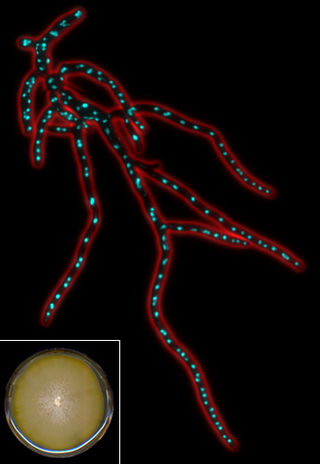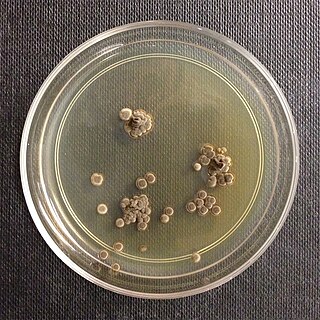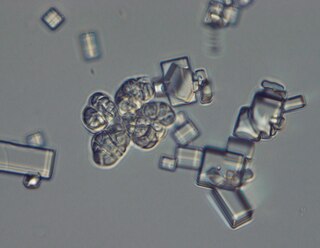Related Research Articles
Halotolerance is the adaptation of living organisms to conditions of high salinity. Halotolerant species tend to live in areas such as hypersaline lakes, coastal dunes, saline deserts, salt marshes, and inland salt seas and springs. Halophiles are organisms that live in highly saline environments, and require the salinity to survive, while halotolerant organisms can grow under saline conditions, but do not require elevated concentrations of salt for growth. Halophytes are salt-tolerant higher plants. Halotolerant microorganisms are of considerable biotechnological interest.

Basidiomycota is one of two large divisions that, together with the Ascomycota, constitute the subkingdom Dikarya within the kingdom Fungi. Members are known as basidiomycetes. More specifically, Basidiomycota includes these groups: agarics, puffballs, stinkhorns, bracket fungi, other polypores, jelly fungi, boletes, chanterelles, earth stars, smuts, bunts, rusts, mirror yeasts, and Cryptococcus, the human pathogenic yeast.

In molecular biology and genetics, GC-content is the percentage of nitrogenous bases in a DNA or RNA molecule that are either guanine (G) or cytosine (C). This measure indicates the proportion of G and C bases out of an implied four total bases, also including adenine and thymine in DNA and adenine and uracil in RNA.
The Saccharomyces Genome Database (SGD) is a scientific database of the molecular biology and genetics of the yeast Saccharomyces cerevisiae, which is commonly known as baker's or budding yeast. Further information is located at the Yeastract curated repository.

Eremothecium gossypii (also known as Ashbya gossypii) is a filamentous fungus or mold closely related to yeast, but growing exclusively in a filamentous way. It was originally isolated from cotton as a pathogen causing stigmatomycosis by Ashby and Nowell in 1926. This disease affects the development of hair cells in cotton bolls and can be transmitted to citrus fruits, which thereupon dry out and collapse (dry rot disease). In the first part of the 20th century, E. gossypii and two other fungi causing stigmatomycosis (Eremothecium coryli, Aureobasidium pullulans) made it virtually impossible to grow cotton in certain regions of the subtropics, causing severe economical losses. Control of the spore-transmitting insects - cotton stainer (Dysdercus suturellus) and Antestiopsis (antestia bugs) - permitted full eradication of infections. E. gossypii was recognized as a natural overproducer of riboflavin (vitamin B2), which protects its spores against ultraviolet light. This made it an interesting organism for industries, where genetically modified strains are still used to produce this vitamin.

Aureobasidium pullulans is a ubiquitous and generalistic black, yeast-like fungus that can be found in different environments. It is well known as a naturally occurring epiphyte or endophyte of a wide range of plant species without causing any symptoms of disease. A. pullulans has a high importance in biotechnology for the production of different enzymes, siderophores and pullulan. Furthermore, A. pullulans is used in biological control of plant diseases, especially storage diseases.
Pathogenic fungi are fungi that cause disease in humans or other organisms. Although fungi are eukaryotic, many pathogenic fungi are microorganisms. Approximately 300 fungi are known to be pathogenic to humans; their study is called "medical mycology". Fungal infections kill more people than either tuberculosis or malaria—about 2 million people per year.

Hortaea werneckii is a species of yeast in the family Teratosphaeriaceae. It is a black yeast that is investigated for its remarkable halotolerance. While the addition of salt to the medium is not required for its cultivation, H. werneckii can grow in close to saturated NaCl solutions. To emphasize this unusually wide adaptability, and to distinguish H. werneckii from other halotolerant fungi, which have lower maximum salinity limits, some authors describe H. werneckii as "extremely halotolerant".

The Wallemiomycetes are a class of fungi in the division Basidiomycota. It consists of the single order Wallemiales, containing the single family Wallemiaceae, which in turn contains the single genus Wallemia. The phylogenetic origin of the lineage was placed to various parts of Basidiomycota, but according to the analysis of a larger dataset it is a sister group of Agaricomycotina. The genus contains species of xerophilic molds that are found worldwide. The seven described species are distinguished by conidial size, xerotolerance, halotolerance, chaotolerance, growth temperature regimes, extracellular enzyme activity profiles, and secondary metabolite patterns. They are typically isolated from low-moisture foods, indoor air dust, salterns and soil. W. sebi is thought to be one of the causes of the hypersensitivity pneumonitis known as the farmer's lung disease, but since the other species were recognised and separated from W. sebi only recently, their role in the disease cannot be excluded.
Saccharomyces eubayanus, a cryotolerant type of yeast, is most likely the parent of the lager brewing yeast, Saccharomyces pastorianus.
Black yeasts, sometimes also black fungi, dematiaceous fungi, microcolonial fungi or meristematic fungi is a diverse group of slow-growing microfungi which reproduce mostly asexually. Only few genera reproduce by budding cells, while in others hyphal or meristematic (isodiametric) reproduction is preponderant. Black yeasts share some distinctive characteristics, in particular a dark colouration (melanisation) of their cell wall. Morphological plasticity, incrustation of the cell wall with melanins and presence of other protective substances like carotenoids and mycosporines represent passive physiological adaptations which enable black fungi to be highly resistant against environmental stresses. The term "polyextremotolerance" has been introduced to describe this phenotype, an example of which is the species Aureobasidium pullulans. Presence of 1,8-dihydroxynaphthalene melanin in the cell wall confers to the microfungi their characteristic olivaceous to dark brown/black colour.

Wallemia sebi is a xerophilic fungus of the phylum Basidiomycota.

Wallemia ichthyophaga is one of the three species of fungi in the genus Wallemia, which in turn is the only genus of the class Wallemiomycetes. The phylogenetic origin of the lineage was placed to various parts of Basidiomycota, but according to the analysis of larger datasets it is a (495-million-years-old) sister group of Agaricomycotina. Although initially believed to be asexual, population genomics found evidence of recombination between strains and a mating type locus was identified in all sequenced genomes of the species.
Previously classified under the species complex Aureobasidium pullulans, Aureobasidium subglaciale is a black yeast-like, extremophile, ascomycete fungus that is found in extreme cold habitats. The species was originally isolated from subglacial ice of arctic glaciers. The first isolate of this species was obtained from subglacial ice of the Norwegian island Spitsbergen, one of the coldest places inhabited by humans. of Genomic data collected from specimens in the Aureobasidium pullulans complex justified distinction of four different species
Aureobasidium melanogenum, formerly known as Aureobasidium pullulans var. melanogenum is a ubiquitous black, yeast-like fungus that is found mainly in freshwater habitats. The species also includes strains causing human infections, which were previously classified as A. pullulans. It was named due to abundant melanin production and accumulation in the cell walls, which leads to dark green, brown or black appearance of the cells and colonies The species was established when the genomes of the four former varieties of Aureobasidium pullulans were sequenced and the large differences between them were discovered.
Aureobasidium namibiae, formerly known as Aureobasidium pullulans var. namibiae is a ubiquitous black, yeast-like fungus. It was described on the basis of only one strain isolated from dolomitic marble in Namibia. The species was established when the genomes of the four former varieties of Aureobasidium pullulans were sequenced and the large differences between them were discovered.

Joseph Heitman is an American physician-scientist focused on research in genetics, microbiology, and infectious diseases. He is the James B. Duke Professor and Chair of the Department of Molecular Genetics and Microbiology at Duke University School of Medicine.
ERG5 or Sterol 22-desaturase is a cytochrome P450 enzyme in the ergosterol biosynthesis pathway of fungi Saccharomyces cerevisiae, with the CYP Symbol CYP61A1. CYP61A1 is one of only three P450 enzyme found in baker's yeast, the other two are CYP51F1 and CYP56A1. The ortholog in Schizosaccharomyces pombe, was named CYP61A3 for historical reasons, and is only one of two P450 enzyme found with CYP51F1. ERG5 catalyzes the C22-C23 double bond formation on the sterol side chain of ergostatrienol to convert it into ergostatetraenol, then the C24 double bond of ergostatetrenol will be hydrogenation reduced into ergosterol by ERG4.
Wallemia mellicola is a xerophilic fungus of the phylum Basidiomycota, described in 2015 upon taxonomic revision of the species Wallemia sebi. A large amount of published research referring to W. sebi was likely actually performed on W. mellicola. An example of this is the sequencing of the W. mellicola genome, which was published under the name of W. sebi.
References
- 1 2 Mohanta TK, Bae H (2015). "The diversity of fungal genome". Biological Procedures Online. 17: 8. doi: 10.1186/s12575-015-0020-z . PMC 4392786 . PMID 25866485.
- 1 2 Stajich JE (July 2017). "Fungal Genomes and Insights into the Evolution of the Kingdom". Microbiology Spectrum. 5 (4): 619–633. doi:10.1128/microbiolspec.FUNK-0055-2016. ISBN 9781555819576. PMC 6078396 . PMID 28820125.
- ↑ Zajc J, Liu Y, Dai W, Yang Z, Hu J, Gostinčar C, Gunde-Cimerman N (September 2013). "Genome and transcriptome sequencing of the halophilic fungus Wallemia ichthyophaga: haloadaptations present and absent". BMC Genomics. 14: 617. doi: 10.1186/1471-2164-14-617 . PMC 3849046 . PMID 24034603.
- ↑ Padamsee M, Kumar TK, Riley R, Binder M, Boyd A, Calvo AM, et al. (March 2012). "The genome of the xerotolerant mold Wallemia sebi reveals adaptations to osmotic stress and suggests cryptic sexual reproduction". Fungal Genetics and Biology. 49 (3): 217–26. doi:10.1016/j.fgb.2012.01.007. PMID 22326418.
- ↑ Morand SC, Bertignac M, Iltis A, Kolder IC, Pirovano W, Jourdain R, Clavaud C (February 2019). "Malassezia restricta CBS 7877, an Opportunist Pathogen Involved in Dandruff and Seborrheic Dermatitis". Microbiology Resource Announcements. 8 (6). doi:10.1128/MRA.01543-18. PMC 6368656 . PMID 30746521.
- ↑ Goffeau A, Barrell BG, Bussey H, Davis RW, Dujon B, Feldmann H, et al. (October 1996). "Life with 6000 genes". Science. 274 (5287): 546, 563–7. Bibcode:1996Sci...274..546G. doi:10.1126/science.274.5287.546. PMID 8849441. S2CID 16763139.
- ↑ Galagan JE, Henn MR, Ma LJ, Cuomo CA, Birren B (December 2005). "Genomics of the fungal kingdom: insights into eukaryotic biology". Genome Research. 15 (12): 1620–31. doi: 10.1101/gr.3767105 . PMID 16339359.
- ↑ Todd RT, Forche A, Selmecki A (July 2017). "Ploidy Variation in Fungi: Polyploidy, Aneuploidy, and Genome Evolution". Microbiology Spectrum. 5 (4): 599–618. doi:10.1128/microbiolspec.FUNK-0051-2016. ISBN 9781555819576. PMC 5656283 . PMID 28752816.
- 1 2 Hane JK, Rouxel T, Howlett BJ, Kema GH, Goodwin SB, Oliver RP (2011-05-24). "A novel mode of chromosomal evolution peculiar to filamentous Ascomycete fungi". Genome Biology. 12 (5): R45. doi: 10.1186/gb-2011-12-5-r45 . PMC 3219968 . PMID 21605470.
- ↑ Tkavc R, Matrosova VY, Grichenko OE, Gostinčar C, Volpe RP, Klimenkova P, et al. (2018). "Rhodotorula taiwanensis MD1149". Frontiers in Microbiology. 8: 2528. doi: 10.3389/fmicb.2017.02528 . PMC 5766836 . PMID 29375494.
- ↑ Peter J, De Chiara M, Friedrich A, Yue JX, Pflieger D, Bergström A, et al. (April 2018). "Genome evolution across 1,011 Saccharomyces cerevisiae isolates". Nature. 556 (7701): 339–344. Bibcode:2018Natur.556..339P. doi:10.1038/s41586-018-0030-5. PMC 6784862 . PMID 29643504.
- ↑ Gostinčar C, Turk M, Zajc J, Gunde-Cimerman N (October 2019). "Fifty Aureobasidium pullulans genomes reveal a recombining polyextremotolerant generalist". Environmental Microbiology. 21 (10): 3638–3652. doi:10.1111/1462-2920.14693. PMC 6852026 . PMID 31112354.
- ↑ Gostinčar C, Sun X, Zajc J, Fang C, Hou Y, Luo Y, et al. (2019-09-04). "Wallemia ichthyophaga". Frontiers in Microbiology. 10: 2019. doi: 10.3389/fmicb.2019.02019 . PMC 6738226 . PMID 31551960.
- ↑ Sun X, Gostinčar C, Fang C, Zajc J, Hou Y, Song Z, Gunde-Cimerman N (June 2019). "Wallemia mellicola". Genes. 10 (6): 427. doi: 10.3390/genes10060427 . PMC 6628117 . PMID 31167502.
- ↑ Gostinčar C, Stajich JE, Zupančič J, Zalar P, Gunde-Cimerman N (May 2018). "Genomic evidence for intraspecific hybridization in a clonal and extremely halotolerant yeast". BMC Genomics. 19 (1): 364. doi: 10.1186/s12864-018-4751-5 . PMC 5952469 . PMID 29764372.
- ↑ Robbertse B, Strope PK, Chaverri P, Gazis R, Ciufo S, Domrachev M, Schoch CL (January 2017). "Improving taxonomic accuracy for fungi in public sequence databases: applying 'one name one species' in well-defined genera with Trichoderma/Hypocrea as a test case". Database. 2017. doi:10.1093/database/bax072. PMC 5641268 . PMID 29220466.
- ↑ Libkind, D.; Čadež, N.; Opulente, D. A.; Langdon, Q. K.; Rosa, C. A.; Sampaio, J. P.; Gonçalves, P.; Hittinger, C. T.; Lachance, M. A. (2020-09-01). "Towards yeast taxogenomics: lessons from novel species descriptions based on complete genome sequences". FEMS Yeast Research. 20 (6). doi: 10.1093/femsyr/foaa042 . ISSN 1567-1364. PMID 32710773.
- ↑ Magain N, Miadlikowska J, Mueller O, Gajdeczka M, Truong C, Salamov AA, et al. (December 2017). "Conserved genomic collinearity as a source of broadly applicable, fast evolving, markers to resolve species complexes: A case study using the lichen-forming genus Peltigera section Polydactylon". Molecular Phylogenetics and Evolution. 117: 10–29. doi: 10.1016/j.ympev.2017.08.013 . hdl: 2268/214605 . PMID 28860010.
- ↑ Gostinčar C, Ohm RA, Kogej T, Sonjak S, Turk M, Zajc J, et al. (July 2014). "Genome sequencing of four Aureobasidium pullulans varieties: biotechnological potential, stress tolerance, and description of new species". BMC Genomics. 15 (1): 549. doi: 10.1186/1471-2164-15-549 . PMC 4227064 . PMID 24984952.
- ↑ Nguyen HD, Sultana T, Kesanakurti P, Hambleton S (2019-07-24). "Tilletia species to identify candidate genes for the detection of regulated species infecting wheat". IMA Fungus. 10 (1): 11. doi: 10.1186/s43008-019-0011-9 . PMC 7184893 . PMID 32355611.
- ↑ Gostinčar C (October 2020). "Towards Genomic Criteria for Delineating Fungal Species". Journal of Fungi. 6 (4): 246. doi: 10.3390/jof6040246 . PMC 7711752 . PMID 33114441.